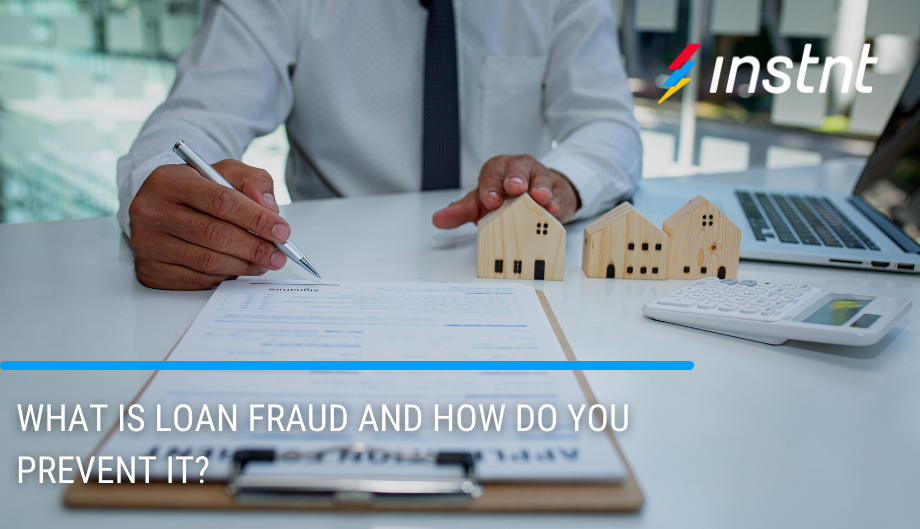
Identity fraud scams are an escalating threat to consumers and businesses. Fraud losses in 2020 alone amounted to $56 billion, according to Businesswire. What is happening when loan fraud occurs, and how can the growing threat be prevented? Discover some of the emergent loan-fraud trends, what it looks like in the digital space versus off-line, and what prevention efforts really look like.
What Is Loan Fraud?
Loan fraud typically victimizes both the lender (a lending firm or financial-services firm) and the alleged borrower when a loan is obtained using a stolen identity. Both digital and brick-and-mortar firms struggle with the challenges of digital identity verification using email, device, and phone-number data. Still, online lending services are at an even greater risk of fraud and often suffer more significant losses.
Loan fraud occurs when false information is used in a loan application. There are many variations of loan fraud; one of the most commonly committed in the U.S. is mortgage fraud. The Federal Bureau of Investigation defines mortgage fraud as any sort of “material misstatement, misrepresentation, or omission relating to the property or potential mortgage relied on by an underwriter or lender to fund, purchase, or insure a loan.”
Current Trends in Loan Fraud
Amidst the COVID-19 pandemic, a new trend in loan fraud emerged, involving the government’s Paycheck Protection Program (PPP), a pandemic assistance program offered to businesses.
While boosting the thriving fintech market, which has increasingly supplanted traditional banking relationships with software apps and algorithms, the $780 billion PPP lending program has fueled fraudulent loans amounting to billions of dollars.
A recent study identified potential PPP fraud in more than 1.8 million loans, amounting to about $76 billion; an estimated 960,000 of these loans, representing $21 billion, were made through new online lenders. The report highlighted loan frauds that may have been facilitated by some relatively new fintech lenders, which were identified based on suspicious lending patterns. However, it also inadvertently emphasized how easy it can be for borrowers to create fake identities and companies with fake headcounts and salaries to get approved for a loan. This is especially true when the transaction is done exclusively online.
Loan Fraud Within the Digital Financial Space
Fintech has opened up greater opportunities for lenders and borrowers. But with more opportunities also comes greater fraud risk, especially when fraudulent borrowers can easily use fake identities instead of stolen ones.
According to Fintech Weekly, the average cost of fraud has increased over the years to a cost of $3.07 per fraudulent dollar. This accounts for 2.24 percent of revenue for large digital lenders.
Reports like this are indicative of the worrisome trend of loan fraud made possible by inadequate identity verification processes for online loan applications.
Loan Fraud Warning Signs
Detecting loan fraud can be challenging; detecting it early enough is even more difficult. However, for business-loan applications, there are warning signs that lenders should always watch out for, including:
- Multiple businesses are registered under one name, especially without a corresponding and verifiable income to support the claim.
- A business without a physical address, which also applies to online businesses.
- Start-up initiatives without a financial and operational history.
- Lack of references.
- Inflated earnings, which are usually accomplished by cooking the books.
- Lack of financial audits.
What about personal loans? With more and more fraudsters using synthetic identities — fabricated credentials not associated with a real person — to apply for loans, there are no complaints about unauthorized accounts, lines of credit, or credit card accounts.
The solution? Fighting technology with technology. Innovations in analytics, machine learning, and customer onboarding processes can help financial services and lending firms fight back against fraudsters. But prevention can still be achieved with an effective identity-verification process.
How To Prevent Loan Fraud
Here’s a guide on how to effectively prevent loan fraud based on synthetic identities:
- ID verification using two or more government-issued IDs.
- Implement Know Your Customer (KYC) and Anti-Money Laundering (AML) compliance.
- Facial recognition using the photo of an ID and a selfie or a short video call.
- Cell phone account verification.
- Identity data verification by cross-referencing identity information with both private and public databases.
- Requesting permission to contact the applicant’s bank or employer to verify financial information.
- Knowledge-based authentication involving an applicant’s credit report; the lender should ask about the information included in the report that the applicant should know, e.g., previous addresses or vehicle purchases.
- Analyzing social network activities associated with the identity provided.
Loan Fraud Management with Instnt
Instnt is the first fully managed digital customer onboarding service for businesses with up to $100MM annually in fraud loss insurance. With codeless integration on websites or apps, Instnt can reduce rejection rates by 50% without friction or fraud, grow top-line revenue, and lower operational costs by 30%. Try a demo today!


